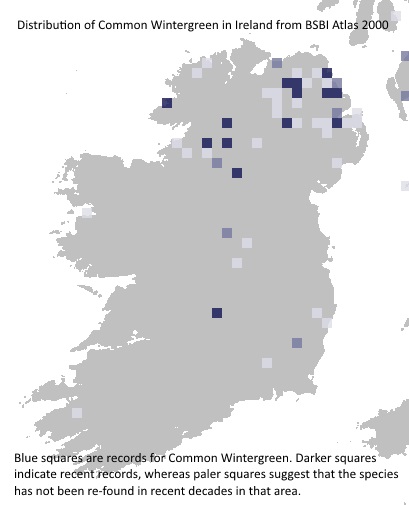Status
Native status
Native
Species Biology
Identification
- Plants grow to between 10 and 25 cm, and flower from June to August.
- They have a loose basal rosette of small (2-4cm) overwintering round-to-oval leaves which have a slightly rounded toothed edge.
- These leaves are alternate and are held on short petioles.
- From the basal rosette a reddish flowering spike grows, which has scale-like leaves and ends in a terminal raceme of white flowers.
- Each flower has a brownish calyx with 5 pointed sepal tips and 5 white petals, which are held curving inwards so that the overall flower shape is ball-like.
- There are 8-10 stamens, and a short straight style, 1-2mm long, that does not protrude from the flower.
- The ovaries are superior and may develop into fruits which remain on the erect stems until the tiny seed is blown away.
Similar/related species:
Round-leaved Wintergreen (Pyrola rotundifolia) is an uncommon and close
relative of Common Wintergreen. It is easily distinguished from Common
Wintergreen when in flower, as it has open saucer-shaped flowers and a long
curved style which protrudes from the petals. There are two subspecies of
Round-leaved Wintergreen in Ireland; subsp.
maritima found in Wexford and Donegal and subsp. rotundifolia which is found in the centre of Ireland in a very
limited geographical area.
Common Wintergreen is more likely to be confused with Intermediate Wintergreen (Pyrola media), since the two species have overlapping distributions. When in flower the two can be told apart by the size of the styles; Intermediate Wintergreen’s flowers are longer (4-6mm) and become widened just under the stigma. The basal leaves of Intermediate Wintergreen have more than 16 teeth on each side and have stomata on the underside only. They are mostly found singly, whereas Common Wintergreen may be in clusters of 2 or 3 basal rosettes.
Habitat
Common Wintergreen grows in damp and shady habitats such as woodlands, valleys and heathland. This species is widespread (but not common) across the northern part of Ireland, but is very uncommon and scattered in the south, where most records are over 20 years old.
Threats faced
Like many habitats in Ireland they are under threat of being lost due to changes in land use, agricultural improvement, and in some cases, drainage.
Distribution
World distribution(GBIF)
BSBI distribution map

Temporal change
Records submitted to Data Centre in 2024
The following map is interactive. If you would prefer to view it full screen then click here.
How can you help
If you have seen Common Wintergreen, or any
of the species in the Irish Species Project, please download the guidance document
for detailed instructions and the recording form where
you can tell us about the plants you’ve seen (also available at http://www.bsbi.org.uk/ireland.html).
You can also get in touch with your local
BSBI Vice County Recorder via Maria Long, BSBI Irish Officer (maria.long@bsbi.org) or contact her if you have any questions.
Further information
One of eight species chosen for the Irish Species Project, a two year recording effort by the Irish division of the Botanical Society of Britain and Ireland (BSBI). All eight species are thought to be declining, at least in parts of their range.
Full list of eight species included in the Irish Species Project:
Moonwort (Botrychium lunaria), Cyperus Sedge (Carex pseudocyperus), Autumn Gentian (Gentianella amarella), Toothwort (Lathraea squamaria), Grass-of-Parnassus (Parnassia palustris), Cowslip (Primula veris), Common Wintergreen (Pyrola minor), Cranberry (Vaccinium oxycoccos)
References
Publications
Parnell J. and Curtis T. (2012) Webb’s An Irish Flora. Cork: Cork
University Press 8th ed.
Poland J. and Clement E. (2009) The vegetative key to the British flora. Southampton:
John Poland in association with The Botanical Society of Britain and Ireland
Preston C.D., Pearman D.A. and Dines T.D.
(2002) New Atlas of the British and Irish
Flora: An Atlas of the Vascular Plants of Britain, Ireland, the Isle of Man and
the Channel Islands. Oxford: Oxford University Press
Rose F. and O’Reilly C. (2006) The Wild Flower Key: how to identify wild
flowers, trees and shrubs in Britain and Ireland. London: Frederick Warne rev.
ed.
Stace C. (2010) New Flora of the British Isles. Cambridge; New York: Cambridge
University Press 2010 3rd ed.
